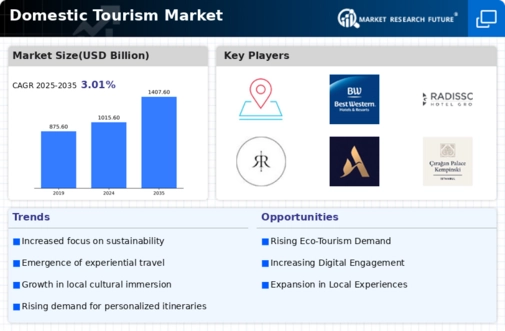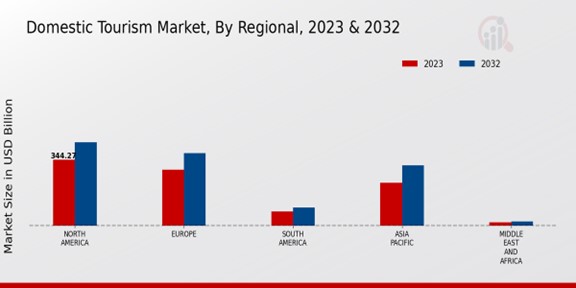Market Growth Projections
The Global Domestic Tourism Market Industry is poised for substantial growth, with projections indicating a market value of 1015.6 USD Billion in 2024 and an anticipated increase to 1407.6 USD Billion by 2035. This growth trajectory suggests a compound annual growth rate (CAGR) of 3.01% from 2025 to 2035, reflecting a robust demand for domestic travel experiences. Factors such as rising disposable incomes, technological advancements, and government support are likely to contribute to this upward trend. The increasing interest in cultural heritage and sustainable travel further underscores the potential for growth within the industry, positioning domestic tourism as a vital component of the global economy.
Rising Disposable Incomes
The Global Domestic Tourism Market Industry is experiencing growth driven by increasing disposable incomes among consumers. As individuals have more financial resources at their disposal, they are more likely to allocate funds towards travel and leisure activities within their own countries. This trend is particularly evident in emerging economies where a burgeoning middle class is eager to explore domestic destinations. For instance, in 2024, the market is projected to reach 1015.6 USD Billion, reflecting a shift in consumer behavior towards domestic travel. This increase in spending power suggests a robust demand for domestic tourism experiences, which could further stimulate the industry.
Technological Advancements
Technological innovations are playing a pivotal role in shaping the Global Domestic Tourism Market Industry. The proliferation of mobile applications and online booking platforms has simplified the travel planning process, making it more accessible for consumers. Enhanced connectivity through social media allows travelers to share experiences, thereby influencing others to explore domestic destinations. In 2024, the market is expected to be valued at 1015.6 USD Billion, indicating a growing reliance on technology in the tourism sector. These advancements not only improve customer engagement but also provide businesses with valuable data to tailor their offerings, potentially leading to increased customer satisfaction and loyalty.
Government Initiatives and Support
Government initiatives aimed at promoting domestic tourism significantly impact the Global Domestic Tourism Market Industry. Various countries are implementing policies to enhance infrastructure, improve accessibility, and promote local attractions. For example, investment in transportation networks and marketing campaigns can encourage citizens to explore their own regions. Such initiatives are likely to contribute to the projected market growth, with estimates suggesting a rise to 1407.6 USD Billion by 2035. This proactive approach by governments not only boosts local economies but also fosters a sense of national pride among citizens, thereby enhancing the appeal of domestic travel.
Cultural Heritage and Local Experiences
The Global Domestic Tourism Market Industry is increasingly influenced by travelers' desire for authentic cultural experiences. As individuals seek to connect with their heritage and explore local traditions, destinations that offer unique cultural attractions are becoming more popular. This trend is evident in the growing interest in local festivals, culinary experiences, and historical sites. The market is projected to grow at a CAGR of 3.01% from 2025 to 2035, indicating a sustained interest in cultural tourism. By promoting local experiences, destinations can attract a diverse range of travelers, thereby enhancing the overall appeal of domestic tourism.
Environmental Awareness and Sustainable Travel
The Global Domestic Tourism Market Industry is witnessing a shift towards more environmentally conscious travel choices. As awareness of environmental issues grows, travelers are increasingly seeking sustainable tourism options that minimize their ecological footprint. This trend is reflected in the rising popularity of eco-friendly accommodations and responsible travel practices. The market's projected growth to 1407.6 USD Billion by 2035 may be partially attributed to this shift, as consumers prioritize sustainability in their travel decisions. Destinations that embrace sustainable practices not only attract eco-conscious travelers but also contribute to the preservation of natural resources, ensuring long-term viability for the tourism sector.












